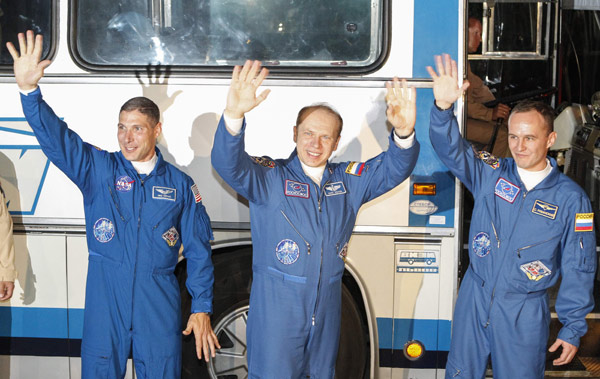Joint Russian-US crew blasts off for space station
Updated: 2013-09-26 14:12
(Agencies)
|
||||||||
A Russian Soyuz rocket blasted off from the Baikonur Cosmodrome in Kazakhstan on Wednesday to deliver three new crew members to the International Space Station.
The Soyuz rocket and capsule lifted off at 4:58 pm EDT/2058 GMT on an express route to the station, which orbits about 250 miles (about 400 km) above Earth.
Veteran Russian commander Oleg Kotov and rookies Sergey Ryazanskiy of Russia and Michael Hopkins of the United States were expected to reach the outpost less than six hours after liftoff. Only two other crews have made the journey as quickly. Previous Soyuz capsules took two days of orbital maneuvers to reach the station.
The arrival of Kotov, Ryazanskiy and Hopkins will return the station to its full, six-member live-aboard crew. Commander Fyodor Yurchikhin, NASA astronaut Karen Nyberg and European Space Agency astronaut Luca Parmitano have been running the station on their own since Sept 10.
The skeleton crew was to have overseen the arrival of a commercial cargo ship on a test flight to the station this week.
But a software problem left the unmanned Cygnus freighter unable to receive navigation data properly from the station, delaying its arrival until no earlier than Saturday to avoid conflicting with the Soyuz's berthing. Typically, at least 48 hours are needed between spacecraft dockings.
The cargo ship, built and launched by Orbital Sciences ing from NASA, blasted off aboard an Antares rocket on Sept 18 from a new launch pad on the Virginia coast.
"As a crew we're very excited to be up there when Cygnus rendezvous and docks and (we're) looking forward to opening that hatch," Hopkins said on Tuesday during a prelaunch press conference.
Hopkins and Ryazanskiy are making their first flights. Kotov, who will take over command of the station when Yurchikhin leaves in November, has made two previous long-duration missions on the station.
During their five-month stay, Kotov and Ryazanskiy are scheduled to make three spacewalks, the first of which will include taking an unlighted Olympic torch outside the airlock to promote the Sochi Olympic Games in Russia, which open in February 2014.
"Our goal here is to make it look spectacular," Kotov, speaking through a translator, told reporters.
"We'd like to showcase our Olympic torch in space. We will try to do it in a beautiful manner. Millions of people will see it live on TV and they will see the station and see how we work," Kotov said.
The torch is scheduled to be delivered to the station on November 6 by the next crew launching to the outpost. Yurchikhin, Nyberg and Parmitano will then bring it back to Earth when they return home four days later so the traditional torch relay can continue.
"Unfortunately we cannot light it in space so we will simply take it to space and take pictures and some video with the station and the Earth in the background," Ryazanskiy said in a prelaunch NASA interview.
An Olympic torch previously flew aboard NASA's now-retired space shuttle Atlantis prior to the 1996 Olympics.

 Djokovic announces engagement to girlfriend
Djokovic announces engagement to girlfriend
 Taipei, LA and Singapore top travel search growth list
Taipei, LA and Singapore top travel search growth list
 Big cats are part of the family
Big cats are part of the family
 Arm exhibition at Russia Arms Expo 2013
Arm exhibition at Russia Arms Expo 2013
 Rubber duck adjusting to spot at Summer Palace
Rubber duck adjusting to spot at Summer Palace
 Suspects in financial offenses arrested in SE Asia
Suspects in financial offenses arrested in SE Asia
 China champs at the bit
China champs at the bit
 Echoes of China
Echoes of China
Most Viewed
Editor's Picks

|

|

|

|

|

|
Today's Top News
Xi reaffirms education top priority
China, Russia issue joint statement on Syria
China to improve policies for overseas investment
Airbus scores in China with $6b in deals
Concern about environment grows
Rich should fight poverty too: Ho
Li Tianyi jailed for 10 years for gang rape
Trending news across China
US Weekly

|

|





